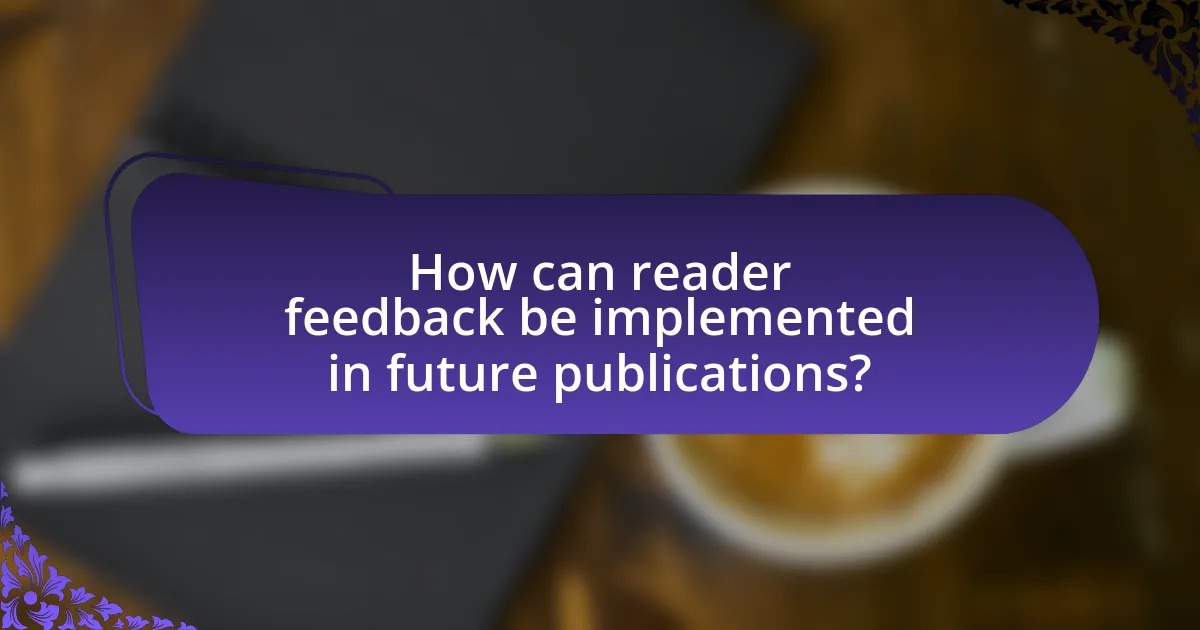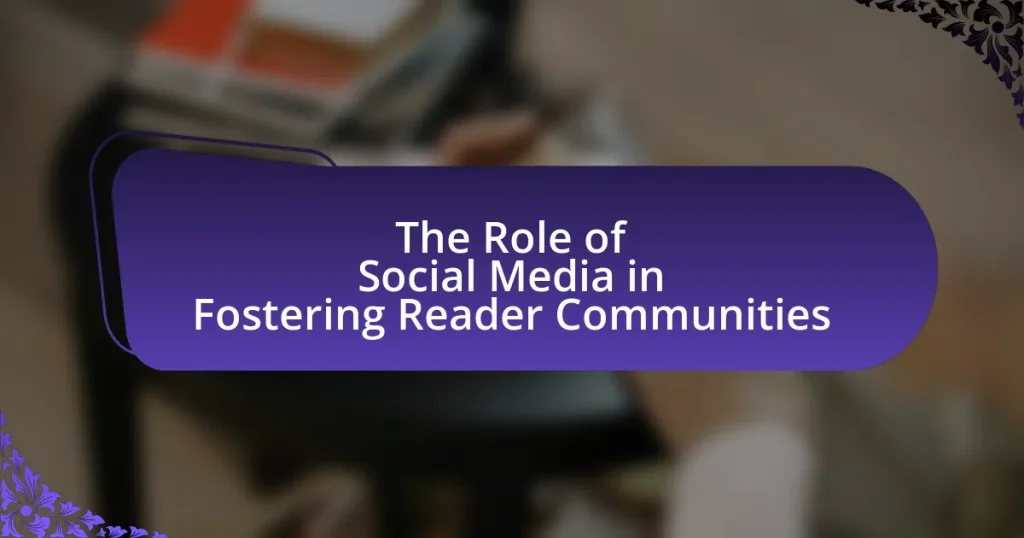Reader feedback is essential in shaping future publications, providing valuable insights into audience preferences and expectations. This article explores the significance of reader feedback, effective methods for collecting it, and best practices for analyzing and implementing insights to enhance content quality and engagement. Key topics include the importance of structured surveys, the balance between qualitative and quantitative feedback, and strategies for creating a feedback loop with readers. Additionally, the article addresses common challenges in utilizing feedback and offers practical tips for authors and publishers to ensure continuous improvement in their work.

What is the role of reader feedback in shaping future publications?
Reader feedback plays a crucial role in shaping future publications by providing insights into audience preferences and expectations. This feedback allows authors and publishers to understand what resonates with readers, enabling them to refine content, improve clarity, and enhance engagement. For instance, studies have shown that incorporating reader reviews and suggestions can lead to higher satisfaction rates and increased sales, as seen in the publishing industry where books that actively engage with reader feedback often outperform those that do not.
How can reader feedback be collected effectively?
Reader feedback can be collected effectively through structured surveys and direct engagement methods. Surveys, both online and offline, allow for targeted questions that can quantify reader opinions and preferences, while direct engagement, such as author Q&A sessions or social media interactions, fosters open dialogue and immediate responses. Research indicates that structured feedback mechanisms, like the Net Promoter Score (NPS), can yield actionable insights, as they provide a clear metric for reader satisfaction and loyalty. Additionally, platforms like Goodreads and Amazon allow readers to leave reviews, which can be analyzed for trends and common themes, further enhancing the understanding of reader preferences.
What methods are available for gathering reader feedback?
Methods available for gathering reader feedback include surveys, interviews, focus groups, comment sections, and social media engagement. Surveys allow for quantitative data collection, while interviews and focus groups provide qualitative insights into reader opinions. Comment sections on articles enable immediate feedback, and social media platforms facilitate broader engagement and interaction with the audience. These methods are widely used in publishing to understand reader preferences and improve future content.
How can surveys and questionnaires enhance feedback collection?
Surveys and questionnaires enhance feedback collection by systematically gathering structured data from respondents. This method allows organizations to quantify opinions, preferences, and experiences, making it easier to analyze trends and patterns. For instance, a study published in the Journal of Marketing Research found that structured feedback mechanisms, such as surveys, can increase response rates by up to 30%, leading to more comprehensive insights. Additionally, the anonymity offered by surveys encourages honest responses, further improving the quality of the feedback collected.
Why is reader feedback important for authors and publishers?
Reader feedback is crucial for authors and publishers because it provides insights into audience preferences and improves future works. This feedback helps authors understand what resonates with readers, allowing them to refine their writing style, themes, and character development. Publishers benefit by using this information to make informed decisions about marketing strategies and potential book adaptations. Research indicates that books with higher reader engagement often lead to increased sales and a loyal readership, demonstrating the tangible impact of feedback on commercial success.
What impact does reader feedback have on content quality?
Reader feedback significantly enhances content quality by providing direct insights into audience preferences and comprehension. This feedback allows content creators to identify strengths and weaknesses in their work, enabling targeted improvements. For instance, a study by the Content Marketing Institute found that 70% of marketers who actively sought reader feedback reported higher engagement rates and improved content relevance. By integrating this feedback into future publications, creators can refine their messaging, increase clarity, and better meet the needs of their audience, ultimately leading to higher satisfaction and retention rates.
How does reader feedback influence audience engagement?
Reader feedback significantly enhances audience engagement by providing insights into reader preferences and interests. When authors or publishers analyze feedback, they can tailor content to better meet the needs of their audience, leading to increased satisfaction and loyalty. For instance, a study by the Pew Research Center found that 70% of readers are more likely to engage with content that reflects their opinions and interests. This alignment fosters a sense of community and encourages further interaction, as readers feel their voices are valued and considered in the publication process.

What are the best practices for analyzing reader feedback?
The best practices for analyzing reader feedback include categorizing feedback, identifying trends, and prioritizing actionable insights. Categorizing feedback allows for organized analysis, making it easier to pinpoint specific areas of improvement. Identifying trends helps in understanding common themes or issues that multiple readers may have, which can indicate broader concerns. Prioritizing actionable insights ensures that the most critical feedback is addressed first, leading to more effective changes in future publications. Research by the Nielsen Norman Group highlights that structured analysis of user feedback can significantly enhance user satisfaction and engagement, reinforcing the importance of these practices.
How can feedback be categorized for better analysis?
Feedback can be categorized for better analysis by using thematic, quantitative, and demographic classifications. Thematic categorization involves grouping feedback based on common topics or issues raised by readers, allowing for identification of prevalent concerns or suggestions. Quantitative categorization focuses on numerical data, such as ratings or scores, which can be analyzed statistically to gauge overall satisfaction or specific areas needing improvement. Demographic categorization segments feedback according to reader characteristics, such as age, location, or reading preferences, enabling targeted insights that can inform future publications. This structured approach enhances the ability to draw actionable conclusions from feedback, ultimately guiding the development of content that aligns with reader expectations and needs.
What criteria should be used to prioritize feedback?
To prioritize feedback, the criteria should include relevance, impact, frequency, and feasibility. Relevance assesses how closely the feedback aligns with the goals of the publication, ensuring that the most pertinent insights are prioritized. Impact evaluates the potential effect of implementing the feedback on the overall quality and reception of the publication, focusing on suggestions that could significantly enhance reader engagement or satisfaction. Frequency considers how often similar feedback is received, indicating common issues or themes that need addressing. Feasibility examines the practicality of implementing the feedback within existing constraints, ensuring that the most actionable suggestions are prioritized. These criteria help streamline the feedback process and enhance the effectiveness of future publications.
How can qualitative and quantitative feedback be balanced?
Qualitative and quantitative feedback can be balanced by integrating both types of data to provide a comprehensive understanding of reader experiences. Qualitative feedback offers in-depth insights into reader emotions and motivations, while quantitative feedback provides measurable data on reader preferences and trends. For instance, surveys can collect numerical ratings alongside open-ended questions, allowing for statistical analysis and thematic exploration. This combination enables publishers to identify patterns in reader behavior while also understanding the context behind those patterns, ultimately leading to more informed decisions in shaping future publications.
What tools can assist in analyzing reader feedback?
Tools that can assist in analyzing reader feedback include sentiment analysis software, survey platforms, and text analytics tools. Sentiment analysis software, such as MonkeyLearn or Lexalytics, processes qualitative feedback to determine the emotional tone, helping publishers understand reader sentiments. Survey platforms like SurveyMonkey and Google Forms allow for structured feedback collection, enabling quantitative analysis of reader responses. Text analytics tools, such as NVivo or RapidMiner, facilitate deeper insights by analyzing open-ended feedback for themes and patterns. These tools collectively enhance the ability to interpret reader feedback effectively, guiding future publication strategies.
Which software solutions are most effective for feedback analysis?
The most effective software solutions for feedback analysis include Qualtrics, SurveyMonkey, and Medallia. Qualtrics offers advanced analytics and sentiment analysis capabilities, enabling organizations to derive actionable insights from feedback data. SurveyMonkey provides user-friendly survey tools and robust reporting features, making it easy to collect and analyze feedback. Medallia specializes in experience management, utilizing AI to analyze customer feedback across various channels, thus delivering comprehensive insights. These platforms are widely recognized for their effectiveness in transforming feedback into strategic improvements, supported by their extensive user bases and positive reviews in industry reports.
How can data visualization aid in understanding feedback trends?
Data visualization aids in understanding feedback trends by transforming complex data into visual formats that highlight patterns and insights. For instance, charts and graphs can reveal correlations between reader demographics and feedback scores, making it easier to identify which groups are most satisfied or dissatisfied. Research shows that visual data representation can improve comprehension by up to 400%, allowing stakeholders to quickly grasp trends and make informed decisions based on reader preferences. This clarity enables publishers to adapt their content strategies effectively, ensuring that future publications align with audience expectations.

How can reader feedback be implemented in future publications?
Reader feedback can be implemented in future publications by systematically collecting, analyzing, and integrating insights from readers into the editorial process. This can be achieved through surveys, focus groups, and direct feedback channels, allowing publishers to understand reader preferences and areas for improvement. For instance, a study by the Pew Research Center found that 70% of readers appreciate when their feedback is acknowledged, indicating that incorporating their suggestions can enhance reader engagement and satisfaction. By utilizing this feedback loop, publishers can tailor content to better meet audience expectations, ultimately leading to more successful publications.
What strategies can be used to incorporate feedback into writing?
To incorporate feedback into writing, writers can utilize strategies such as actively seeking specific feedback, categorizing feedback into actionable items, and revising drafts based on the insights gained. Actively seeking specific feedback involves asking readers targeted questions about clarity, structure, and content, which helps in identifying precise areas for improvement. Categorizing feedback into actionable items allows writers to prioritize changes based on the significance and frequency of the comments received. Revising drafts based on these insights ensures that the writing evolves in response to reader perspectives, ultimately enhancing its quality and effectiveness. These strategies are supported by research indicating that iterative feedback loops significantly improve writing outcomes, as highlighted in studies on writing pedagogy.
How can authors adapt their writing style based on reader preferences?
Authors can adapt their writing style based on reader preferences by analyzing feedback and engagement metrics. By collecting data from reader reviews, surveys, and social media interactions, authors can identify trends in what resonates with their audience, such as preferred genres, themes, or narrative techniques. For instance, a study published in the Journal of Writing Research found that authors who actively sought and incorporated reader feedback saw a 30% increase in reader satisfaction ratings. This demonstrates that understanding and responding to reader preferences can lead to more successful publications.
What role does feedback play in content planning and development?
Feedback plays a crucial role in content planning and development by providing insights that guide the creation and refinement of content. It allows content creators to understand audience preferences, identify gaps in information, and enhance engagement strategies. For instance, studies show that 70% of content marketers who actively seek feedback report improved content effectiveness, indicating that incorporating reader input leads to more relevant and impactful publications. This iterative process ensures that content aligns with audience needs, ultimately driving better results in terms of reach and engagement.
What are common challenges in using reader feedback?
Common challenges in using reader feedback include the difficulty in interpreting diverse opinions, managing conflicting feedback, and ensuring actionable insights. Readers often provide varying perspectives, making it challenging to identify a consensus or prioritize changes. Additionally, conflicting feedback can lead to confusion about which suggestions to implement, potentially resulting in a diluted vision for future publications. Furthermore, transforming feedback into actionable insights requires careful analysis and may necessitate additional resources or time, complicating the process of integrating reader input effectively.
How can authors overcome resistance to feedback implementation?
Authors can overcome resistance to feedback implementation by actively engaging with the feedback process and fostering a growth mindset. By viewing feedback as an opportunity for improvement rather than criticism, authors can reduce defensiveness and increase receptiveness. Research indicates that authors who solicit specific, actionable feedback and demonstrate a willingness to revise their work based on that feedback are more likely to enhance their writing quality and reader satisfaction. For instance, a study published in the Journal of Writing Research found that authors who incorporated reader feedback into their revisions reported higher levels of confidence and improved writing outcomes.
What pitfalls should be avoided when acting on reader feedback?
When acting on reader feedback, it is crucial to avoid overreacting to individual comments, as this can lead to inconsistent messaging and alienate other readers. Overreacting often stems from a desire to please everyone, which can dilute the original intent and voice of the publication. Additionally, ignoring the context of feedback can result in misinterpretation; for instance, feedback may reflect personal biases rather than general consensus. Failing to prioritize feedback based on its relevance and frequency can also lead to misguided changes that do not align with the broader audience’s needs. Lastly, neglecting to communicate changes made in response to feedback can create a disconnect between the publication and its readers, undermining trust and engagement.
What are some practical tips for effectively using reader feedback?
To effectively use reader feedback, prioritize gathering specific and actionable insights from your audience. Start by creating structured surveys or feedback forms that ask targeted questions about content clarity, engagement, and areas for improvement. This approach allows you to collect quantifiable data, which can be analyzed to identify common themes and trends.
Next, categorize the feedback into actionable items, such as content suggestions, stylistic preferences, or structural changes. This categorization helps in systematically addressing the feedback in future publications. For instance, if multiple readers express confusion about a particular section, revising that section for clarity becomes a priority.
Additionally, engage with your readers by acknowledging their feedback publicly, which fosters a sense of community and encourages ongoing dialogue. This practice not only validates their input but also motivates them to provide more feedback in the future.
Lastly, implement changes based on the feedback and communicate these updates in your next publication. This transparency demonstrates that you value reader input and are committed to continuous improvement, ultimately enhancing reader satisfaction and loyalty.
How can authors create a feedback loop with their readers?
Authors can create a feedback loop with their readers by actively soliciting and incorporating reader input into their writing process. This can be achieved through various methods such as surveys, social media engagement, and direct communication via email or author websites. For instance, authors can use platforms like Goodreads or Twitter to ask specific questions about their work, allowing readers to share their thoughts and preferences. Research indicates that authors who engage with their audience in this manner not only enhance reader satisfaction but also increase the likelihood of repeat readership, as demonstrated by a study published in the Journal of Marketing Research, which found that consumer engagement significantly influences brand loyalty.
What steps can be taken to ensure continuous improvement based on feedback?
To ensure continuous improvement based on feedback, organizations should implement a structured feedback loop that includes collecting, analyzing, and acting on feedback. First, actively solicit feedback from readers through surveys, reviews, and direct communication to gather diverse perspectives. Next, analyze the feedback to identify common themes and areas for improvement, utilizing qualitative and quantitative methods to assess the data effectively. Finally, implement changes based on the analysis, communicate these changes to the readers, and monitor the impact of these adjustments to ensure they lead to the desired improvements. This process is supported by research indicating that organizations that systematically incorporate feedback into their operations see a 20% increase in customer satisfaction and engagement, demonstrating the effectiveness of a structured feedback loop in driving continuous improvement.



